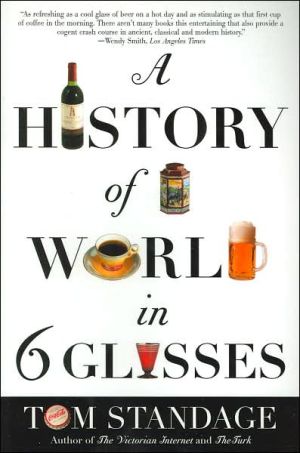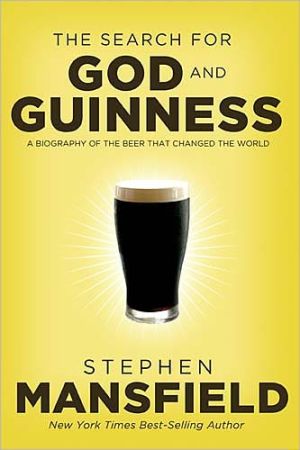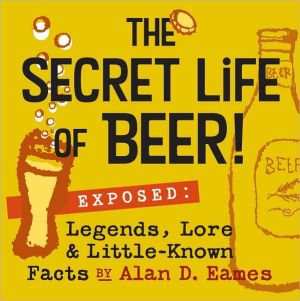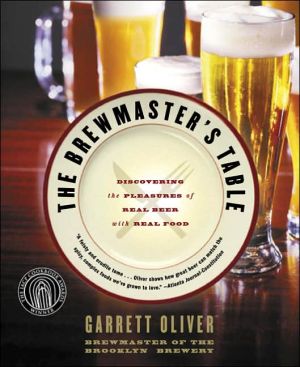History of the World in 6 Glasses
From beer to Coca-Cola, the six drinks that have helped shape human history Throughout human history, certain drinks have done much more than just quench thirst. As Tom Standage relates with authority and charm, six of them have had a surprisingly pervasive influence on the course of history, becoming the defining drink during a pivotal historical period.\ A History of the World in 6 Glasses tells the story of humanity from the Stone Age to the 21st century through the lens of beer, wine,...
Search in google:
From beer to Coca-Cola, the six drinks that have helped shape human history.Throughout human history. certain drinks have done much more than just quench thirst. As Tom Standage relates with authority and charm, six of them have had a surprisingly pervasive influence on the course of history, becoming the defining drink during a pivotal historical period.A History of the World in 6 Glasses tells the story of humanity from the Stone Age to the 21st century through the lens of beer, wine, spirits, coffee, tea, and cola. Beer was first made in the Fertile Crescent and by 3000 B.C.E. was so important to Mesopotamia and Egypt that it was used to pay wages. In ancient Greece wine became the main export of her vast seaborne trade, helping spread Greek culture abroad. Spirits such as brandy and rum fueled the Age of Exploration, fortifying seamen on long voyages and oiling the pernicious slave trade. Although coffee originated in the Arab world, it stoked revolutionary thought in Europe during the Age of Reason, when coffeehouses became centers of intellectual exchange. And hundreds of years after the Chinese began drinking tea, it became especially popular in Britain, with far-reaching effects on British foreign policy. Finally, though carbonated drinks were invented in 18th-century Europe they became a 20th-century phenomenon, and Coca-Cola in particular is the leading symbol of globalization.For Tom Standage, each drink is a kind of technology, a catalyst for advancing culture by which he demonstrates the intricate interplay of different civilizations. You may never look at your favorite drink the same way again. The New York Times - Janet Maslin Highlights of this drink's long, checkered history include its early links to quack medicinal remedies, the court case United States v. Forty Barrels and Twenty Kegs of Coca-Cola, and the way colorless Coke was passed off as vodka by a Soviet military leader who dared not be associated with such a capitalist totem. Coca-Cola's presence in the hot, parched Middle East is seen as no less tricky. As in the book's other sections, Mr. Standage manages to be incisive, illuminating and swift without belaboring his analysis.
The History of the World in 6 Glasses\ \ By Tom Standage \ Walker & Company\ Copyright © 2005 Tom Standage\ All right reserved.\ ISBN: 0-8027-1447-1 \ \ \ Chapter One\ Fermentation and civilization are inseparable. -John Ciardi, American poet (1916-86)\ A Pint of Prehistory\ The humans who migrated out of Africa starting around 50,000 years ago traveled in small nomadic bands, perhaps thirty strong, and lived in caves, huts, or skin tents. They hunted game, caught fish and shellfish, and gathered edible plants, moving from one temporary camp to another to exploit seasonal food supplies. Their tools included bows and arrows, fishhooks, and needles. But then, starting around 12,000 years ago, a remarkable shift occurred. Humans in the Near East abandoned the old hunter-gatherer lifestyle of the Paleolithic period (old stone age) and began to take up farming instead, settling down in villages which eventually grew to become the world's first cities. They also developed many new technologies, including pottery, wheeled vehicles, and writing.\ Ever since the emergence of "anatomically modern" humans, or Homo sapiens sapiens, in Africa around 150,000 years ago, water had been humankind's basic drink. A fluid of primordial importance, it makes up two-thirds of the human body, and no life on Earth can exist without it. But with the switch from the hunter-gatherer lifestyle to a more settled way of life, humans came to rely on a new beverage derived from barley and wheat, the cereal grains that were the first plants to be deliberately cultivated. This drink became central to social, religious, and economic life and was the staple beverage of the earliest civilizations. It was the drink that first helped humanity along the path to the modern world: beer.\ Exactly when the first beer was brewed is not known. There was almost certainly no beer before 10,000 BCE, but it was widespread in the Near East by 4000 BCE, when it appears in a pictogram from Mesopotamia, a region that corresponds to modern-day Iraq, depicting two figures drinking beer through reed straws from a large pottery jar. (Ancient beer had grains, chaff, and other debris floating on its surface, so a straw was necessary to avoid swallowing them.)\ Since the first examples of writing date from around 3400 BCE, the earliest written documents can shed no direct light on beer's origins. What is clear, however, is that the rise of beer was closely associated with the domestication of the cereal grains from which it is made and the adoption of farming. It came into existence during a turbulent period in human history that witnessed the switch from a nomadic to a settled lifestyle, followed by a sudden increase in social complexity manifested most strikingly in the emergence of cities. Beer is a liquid relic from human prehistory, and its origins are closely intertwined with the origins of civilization itself.\ Beer was not invented but discovered. Its discovery was inevitable once the gathering of wild grains became widespread after the end of the last ice age, around 10,000 BCE, in a region known as the Fertile Crescent. This area stretches from modern-day Egypt, up the Mediterranean coast to the southeast corner of Turkey, and then down again to the border between Iraq and Iran. It is so named because of a happy accident of geography. When the ice age ended, the uplands of the region provided an ideal environment for wild sheep, goats, cattle, and pigs-and, in some areas, for dense stands of wild wheat and barley. This meant the Fertile Crescent provided unusually rich pickings for roving bands of human hunter-gatherers. They not only hunted animals and gathered edible plants but collected the abundant cereal grains growing wild in the region.\ Such grains provided an unexciting but reliable source of food. Although unsuitable for consumption when raw, they can be made edible by roughly pounding or crushing them and then soaking them in water. Initially, they were probably just mixed into soup. A variety of ingredients such as fish, nuts, and berries would have been mixed with water in a plastered or bitumen-lined basket. Stones, heated in a fire, were then dropped in, using a forked stick. Grains contain tiny granules of starch, and when placed in hot water they absorb moisture and then burst, releasing the starch into the soup and thickening it considerably.\ Cereal grains, it was soon discovered, had another unusual property: Unlike other foodstuffs, they could be stored for consumption months or even years later, if kept dry and safe. When no other foodstuffs were available to make soup, they could be used on their own to make either a thick porridge or a thin broth or gruel. This discovery led to the development of tools and techniques to collect, process, and store grain. It involved quite a lot of effort but provided a way to guard against the possibility of future food shortages. Throughout the Fertile Crescent there is archaeological evidence from around 10,000 BCE of flint-bladed sickles for harvesting cereal grains, woven baskets for carrying them, stone hearths for drying them, underground pits for storing them, and grindstones for processing them.\ Although hunter-gatherers had previously led semisettled rather than entirely nomadic lives, moving between a number of temporary or seasonal shelters, the ability to store cereal grains began to encourage people to stay in one place. An experiment carried out in the 1960s shows why. An archaeologist used a flint-bladed sickle to see how efficiently a prehistoric family could have harvested wild grains, which still grow in some parts of Turkey. In one hour he gathered more than two pounds of grain, which suggested that a family that worked eight-hour days for three weeks would have been able to gather enough to provide each family member with a pound of grain a day for a year. But this would have meant staying near the stands of wild cereals to ensure the family did not miss the most suitable time to harvest them. And having gathered a large quantity of grain, they would be reluctant to leave it unguarded.\ The result was the first permanent settlements, such as those established on the eastern coast of the Mediterranean from around 10,000 BCE. They consisted of simple, round huts with roofs supported by wooden posts and floors sunk up to a yard into the ground. These huts usually had a hearth and a floor paved with stones and were four or five yards in diameter. A typical village consisted of around fifty huts, supporting a community of two hundred or three hundred people. Although the residents of such villages continued to hunt wild animals such as gazelles, deer, and boar, skeletal evidence suggests that they subsisted on a mainly plant-based diet of acorns, lentils, chickpeas, and cereals, which at this stage were still gathered in the wild, rather than cultivated deliberately.\ Cereal grains, which started off as relatively unimportant foodstuffs, took on greater significance following the discovery that they had two more unusual properties. The first was that grain soaked in water, so that it starts to sprout, tastes sweet. It was difficult to make storage pits perfectly watertight, so this property would have become apparent as soon as humans first began to store grain. The cause of this sweetness is now understood: Moistened grain produces diastase enzymes, which convert starch within the grain into maltose sugar, or malt. (This process occurs in all cereal grains, but barley produces by far the most diastase enzymes and hence the most maltose sugar.) At a time when few other sources of sugar were available, the sweetness of this "malted" grain would have been highly valued, prompting the development of deliberate malting techniques, in which the grain was first soaked and then dried.\ The second discovery was even more momentous. Gruel that was left sitting around for a couple of days underwent a mysterious transformation, particularly if it had been made with malted grain: It became slightly fizzy and pleasantly intoxicating, as the action of wild yeasts from the air fermented the sugar in the gruel into alcohol. The gruel, in short, turned into beer.\ Even so, beer was not necessarily the first form of alcohol to pass human lips. At the time of beer's discovery, alcohol from the accidental fermentation of fruit juice (to make wine) or water and honey (to make mead) would have occurred naturally in small quantities as people tried to store fruit or honey. But fruit is seasonal and perishes easily, wild honey was only available in limited quantities, and neither wine nor mead could be stored for very long without pottery, which did not emerge until around 6000 BCE. Beer, on the other hand, could be made from cereal crops, which were abundant and could be easily stored, allowing beer to be made reliably, and in quantity, when needed. Long before pottery was available, it could have been brewed in pitch-lined baskets, leather bags or animal stomachs, hollowed-out trees, large shells, or stone vessels. Shells were used for cooking as recently as the nineteenth century in the Amazon basin, and Sahti, a traditional beer made in Finland, is still brewed in hollowed-out trees today.\ Once the crucial discovery of beer had been made, its quality was improved through trial and error. The more malted grain there is in the original gruel, for example, and the longer it is left to ferment, the stronger the beer. More malt means more sugar, and a longer fermentation means more of the sugar is turned into alcohol. Thoroughly cooking the gruel also contributes to the beer's strength. The malting process converts only around 15 percent of the starch found in barley grains into sugar, but when malted barley is mixed with water and brought to the boil, other starch-converting enzymes, which become active at higher temperatures, turn more of the starch into sugar, so there is more sugar for the yeast to transform into alcohol.\ Ancient brewers also noticed that using the same container repeatedly for brewing produced more reliable results. Later historical records from Egypt and Mesopotamia show that brewers always carried their own "mash tubs" around with them, and one Mesopotamian myth refers to "containers which make the beer good." Repeated use of the same mash tub promoted successful fermentation because yeast cultures took up residence in the container's cracks and crevices, so that there was no need to rely on the more capricious wild yeast. Finally, adding berries, honey, spices, herbs, and other flavorings to the gruel altered the taste of the resulting beer in various ways. Over the next few thousand years, people discovered how to make a variety of beers of different strengths and flavors for different occasions.\ Later Egyptian records mention at least seventeen kinds of beer, some of them referred to in poetic terms that sound, to modern ears, almost like advertising slogans: Different beers were known as "the beautiful and good," "the heavenly," "the joy-bringer," "the addition to the meal," "the plentiful," "the fermented." Beers used in religious ceremonies also had special names. Similarly, early written references to beer from Mesopotamia, in the third millennium BCE, list over twenty different kinds, including fresh beer, dark beer, fresh-dark beer, strong beer, red-brown beer, light beer, and pressed beer. Red-brown beer was a dark beer made using extra malt, while pressed beer was a weaker, more watery brew that contained less grain. Mesopotamian brewers could also control the taste and color of their beer by adding different amounts of bappir, or beer-bread. To make bappir, sprouted barley was shaped into lumps, like small loaves, which were baked twice to produce a dark-brown, crunchy, unleavened bread that could be stored for years before being crumbled into the brewer's vat. Records indicate that bappir was kept in government storehouses and was only eaten during food shortages; it was not so much a foodstuff as a convenient way to store the raw material for making beer.\ The Mesopotamian use of bread in brewing has led to much debate among archaeologists, some of whom have suggested that bread must therefore be an offshoot of beer making, while others have argued that bread came first and was subsequently used as an ingredient in beer. It seems most likely, however, that both bread and beer were derived from gruel. A thick gruel could be baked in the sun or on a hot stone to make flatbread; a thin gruel could be left to ferment into beer. The two were different sides of the same coin: Bread was solid beer, and beer was liquid bread.\ Under the Influence of Beer?\ Since writing had not been invented at the time, there are no written records to attest to the social and ritual importance of beer in the Fertile Crescent during the new stone age, or Neolithic period, between 9000 BCE and 4000 BCE. But much can be inferred from later records of the way beer was used by the first literate civilizations, the Sumerians of Mesopotamia and the ancient Egyptians. Indeed, so enduring are the cultural traditions associated with beer that some of them survive to this day.\ From the start, it seems that beer had an important function as a social drink. Sumerian depictions of beer from the third millennium BCE generally show two people drinking through straws from a shared vessel. By the Sumerian period, however, it was possible to filter the grains, chaff, and other debris from beer, and the advent of pottery meant it could just as easily have been served in individual cups. That beer drinkers are, nonetheless, so widely depicted using straws suggests that it was a ritual that persisted even when straws were no longer necessary.\ The most likely explanation for this preference is that, unlike food, beverages can genuinely be shared. When several people drink beer from the same vessel, they are all consuming the same liquid; when cutting up a piece of meat, in contrast, some parts are usually deemed to be more desirable than others. As a result, sharing a drink with someone is a universal symbol of hospitality and friendship. It signals that the person offering the drink can be trusted, by demonstrating that it is not poisoned or otherwise unsuitable for consumption. The earliest beer, brewed in a primitive vessel in an era that predated the use of individual cups, would have to have been shared. Although it is no longer customary to offer visitors a straw through which to drink from a communal vat of beer, today tea or coffee may be offered from a shared pot, or a glass of wine or spirits from a shared bottle. And when drinking alcohol in a social setting, the clinking of glasses symbolically reunites the glasses into a single vessel of shared liquid. These are traditions with very ancient origins.\ \ Continues... \ \ \ \ Excerpted from The History of the World in 6 Glasses by Tom Standage Copyright © 2005 by Tom Standage . Excerpted by permission.\ All rights reserved. No part of this excerpt may be reproduced or reprinted without permission in writing from the publisher.\ Excerpts are provided by Dial-A-Book Inc. solely for the personal use of visitors to this web site. \ \
Introduction : vital fluids11A stone-age brew92Civilized beer243The delight of wine434The imperial vine695High spirits, high seas936The drinks that built America1127The great soberer1338The coffeehouse Internet1519Empires of tea17510Tea power19811From soda to cola22312Globalization in a bottle250Epilogue : back to the source266AppIn search of ancient drinks277
\ Janet MaslinHighlights of this drink's long, checkered history include its early links to quack medicinal remedies, the court case United States v. Forty Barrels and Twenty Kegs of Coca-Cola, and the way colorless Coke was passed off as vodka by a Soviet military leader who dared not be associated with such a capitalist totem. Coca-Cola's presence in the hot, parched Middle East is seen as no less tricky. As in the book's other sections, Mr. Standage manages to be incisive, illuminating and swift without belaboring his analysis.\ — The New York Times\ \ \ \ \ Publishers WeeklyStandage starts with a bold hypothesis-that each epoch, from the Stone Age to the present, has had its signature beverage-and takes readers on an extraordinary trip through world history. The Economist's technology editor has the ability to connect the smallest detail to the big picture and a knack for summarizing vast concepts in a few sentences. He explains how, when humans shifted from hunting and gathering to farming, they saved surplus grain, which sometimes fermented into beer. The Greeks took grapes and made wine, later borrowed by the Romans and the Christians. Arabic scientists experimented with distillation and produced spirits, the ideal drink for long voyages of exploration. Coffee also spread quickly from Arabia to Europe, becoming the "intellectual counterpoint to the geographical expansion of the Age of Exploration." European coffee-houses, which functioned as "the Internet of the Age of Reason," facilitated scientific, financial and industrial cross-fertilization. In the British industrial revolution that followed, tea "was the lubricant that kept the factories running smoothly." Finally, the rise of American capitalism is mirrored in the history of Coca-Cola, which started as a more or less handmade medicinal drink but morphed into a mass-produced global commodity over the course of the 20th century. In and around these grand ideas, Standage tucks some wonderful tidbits-on the antibacterial qualities of tea, Mecca's coffee trials in 1511, Visigoth penalties for destroying vineyards-ending with a delightful appendix suggesting ways readers can sample ancient beverages. 24 b&w illus. Agent, Katinka Matson. (June) Copyright 2005 Reed Business Information.\ \ \ Kirkus ReviewsTechnology historian Standage (The Turk, 2002, etc.) follows the flow of civilization as humanity guzzles a half-dozen prime beverages. First made by nature in prehistory was beer. Finding it good, and more salubrious than plain water, mankind turned brewer. (And so the stage was set for cartoons set in barrooms eons later). From cuneiform beer ledgers, Standage's story hops to Dionysus and the oenophiles of Greece and Rome, who knew as much about the pleasures of the grape as any modern wine snob. Here, we learn the vintage that Caligula preferred. In C-rdoba, distilled spirits formed rum. Allotments of rum, in turn, enhanced the fighting effectiveness of British tars against foreign sailors debilitated by scurvy. The attempt to pay for the recent revolution by imposing federal taxes on independent stills produced the short-lived Whiskey Rebellion in the new United States. Islam eschewed booze, but a sober gift from the Arab world was coffee. In 17th-century Europe, coffeehouses were not only as ubiquitous as Starbucks, they were "information exchanges" where people traded news as "vibrant and unreliable" as that found on a contemporary Internet blog. Tea, which tradition holds was first brewed some 4,500 years ago (our author dates it closer to the first century), became largely controlled, along with opium, by the East India Company. From British tea-time dominance, beverage history goes to that fizzy badge of American hegemony, Coca-Cola. We learn why drugstores once featured soda fountains and how Coke fought Pepsi in WWII. Don't drink the water: throughout history, beer, wine, whiskey, coffee, tea and soda pop were all more potable. Ironically, now that it's bottled and pricey,water seems to making a comeback. Standage offers a distilled account of civilization founded on the drinking habits of mankind from the days of hunter-gatherers to yesterday's designer thirst-quencher. History, along with a bit of technology, etymology, chemistry and bibulous entertainment. Bottoms up! (24 b&w illustrations)\ \ \ \ \ From the Publisher"Sean Runnette's composed voice is like the lining of an oak cask holding a refined concoction, imparting a bit of its flavor on the contents but never overpowering the brew. His narration is perfect for Standage's insightful history of some of humankind's greatest pleasures." —-AudioFile\ \







